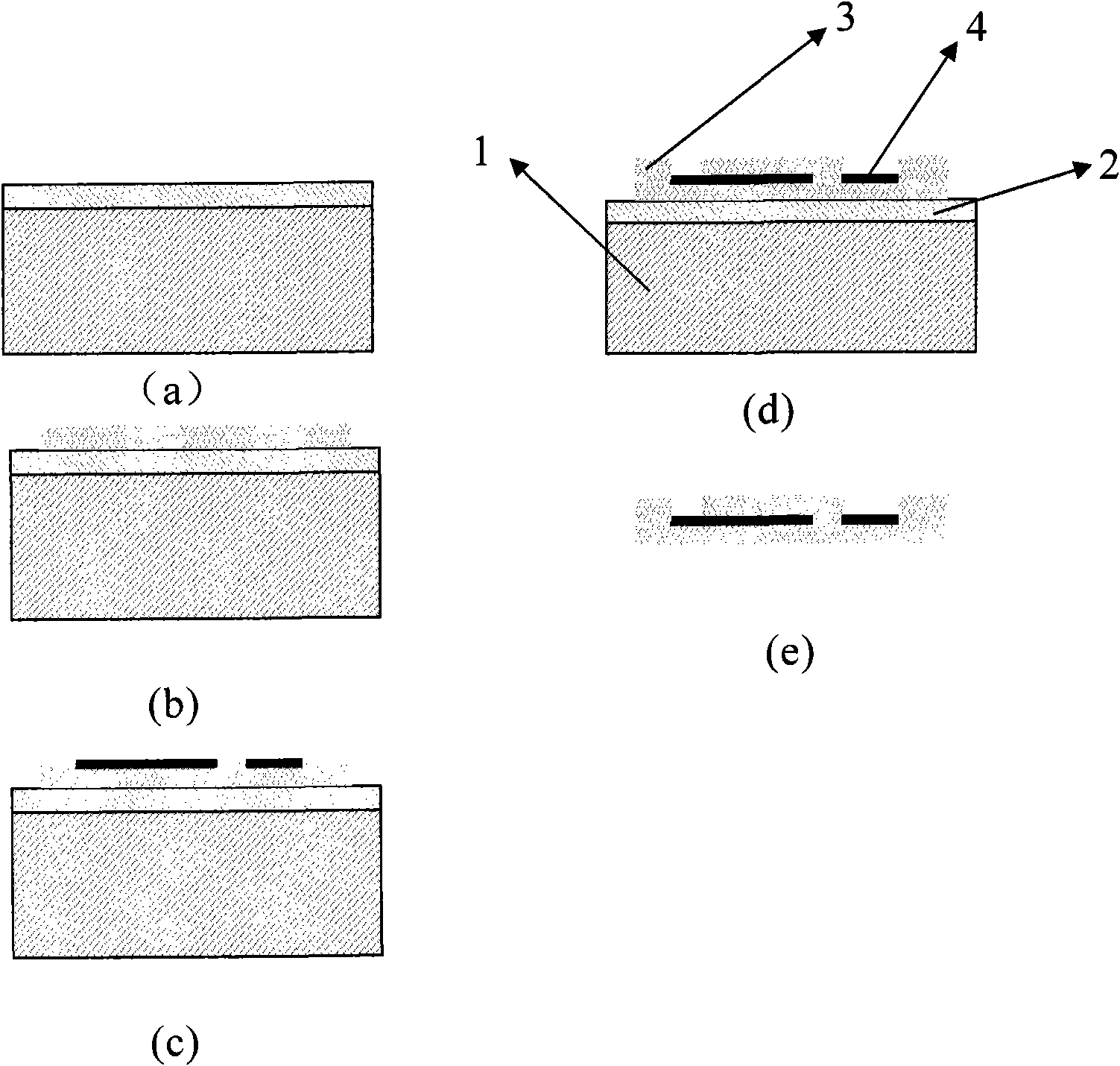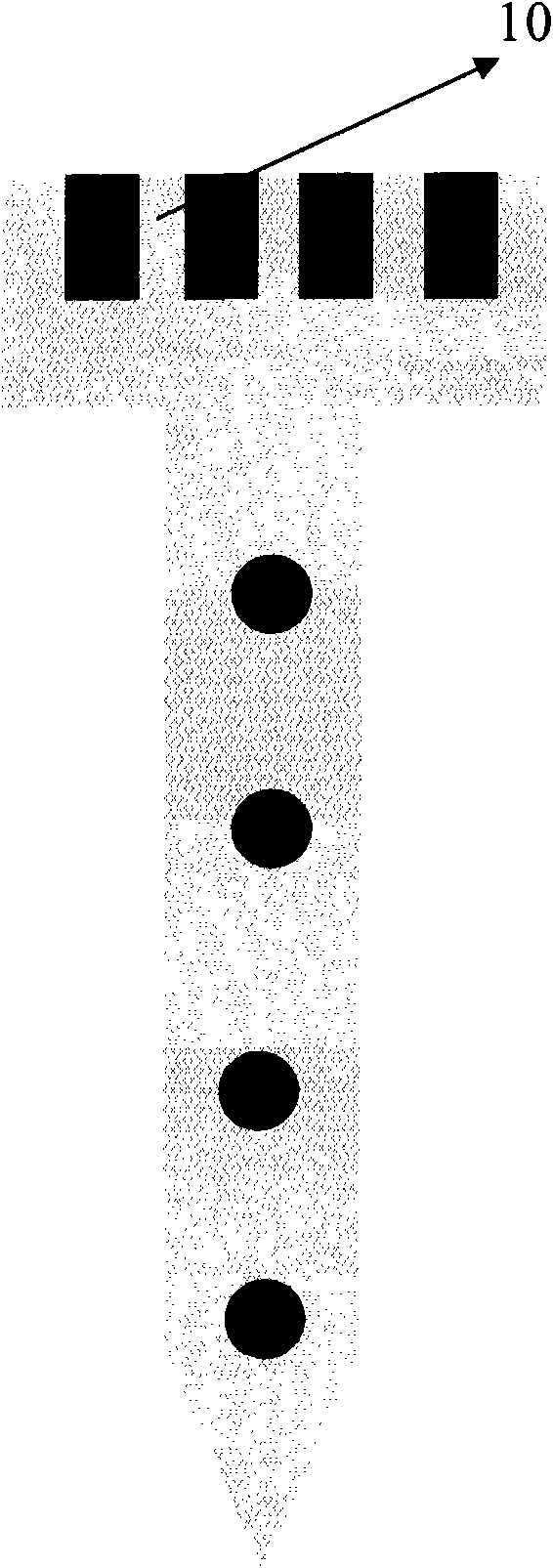Flexible probe electrode used for recording electric signal of neural activity and implanting tool thereof
A nerve activity, probe electrode technology, applied in the fields of neurobiology, materials science and microelectronics, can solve the problem that flexible electrodes cannot meet the implantation hardness and other problems, so as to ensure long-term stability, reduce tissue damage, and improve tissue Injury and the effect of electrode instability in long-term recording of electrical signals
- Summary
- Abstract
- Description
- Claims
- Application Information
AI Technical Summary
Problems solved by technology
Method used
Image
Examples
Embodiment 1
[0031] The preparation method of the flexible probe-type electrode based on the polymer substrate of the present invention is further described below in conjunction with the accompanying drawings by taking polyimide polymer as an example
[0032] 1. Soak the silicon wafer 1 in a mixture of concentrated sulfuric acid and hydrogen peroxide (5:1), boil it, rinse it with a large amount of deionized water, blow dry, and dry it in a 250° oven to remove the surface moisture of the silicon wafer. Evaporate 300nm thick aluminum metal 2 as a sacrificial layer, (eg figure 1 (a) shown).
[0033] 2. Spin-coat polyimide photoresist 3, pre-baked to form the underlying polyimide film, photoetch the electrode morphology, and finally cure with a stepwise heating method to obtain a polyimide film with a thickness of about 5 microns. Amine films are used as the underlying insulating material for microelectrodes, (eg figure 1 (b) shown).
[0034] 3. A patterned titanium-gold metal film 4 is for...
Embodiment 2
[0038]The method of making the carrier will be further described by taking silicon material as an example in conjunction with the accompanying drawings.
[0039] 1, prepare SOI substrate 7 and clean, (as Figure 4 (a) shown).
[0040] 2. Spin-coat the photoresist, photoetch the topography of the carrier 11 after pre-baking, (such as Figure 4 (b) shown).
[0041] 3. Etch the SiO in the SOI substrate 7 with HF 2 Layer 6, the carrier 11 is released, (as Figure 4 (c) shown).
Embodiment 3
[0043] The method of penetrating the flexible probe electrode into the biological tissue with the help of the implant tool will be further described below in conjunction with the accompanying drawings.
[0044] 1. Coat the hot-melt PEG on the carrier 11, clamp the flexible probe electrode 10 with tweezers 9, put it on the carrier 11, then cool it, and the PEG is solidified. At this time, the carrier 11, the electrode 10 and the solid PEG 8 form a rigid whole, (such as Image 6 shown).
[0045] 2. Use tweezers 9 to pierce the probe electrode 10 into the position to be recorded in the biological tissue 12, and the solid PEG 8 will be dissolved in body fluid, (such as Figure 7 shown).
[0046] 3. Pull out the carrier 11 from the body with tweezers 9, leaving only the flexible probe electrode 10 in the body 12, (such as Figure 8 shown).
[0047] Using this method has the advantages of easy and precise penetration into the recording position, no tissue damage, and good reliab...
PUM
 Login to View More
Login to View More Abstract
Description
Claims
Application Information
 Login to View More
Login to View More - R&D
- Intellectual Property
- Life Sciences
- Materials
- Tech Scout
- Unparalleled Data Quality
- Higher Quality Content
- 60% Fewer Hallucinations
Browse by: Latest US Patents, China's latest patents, Technical Efficacy Thesaurus, Application Domain, Technology Topic, Popular Technical Reports.
© 2025 PatSnap. All rights reserved.Legal|Privacy policy|Modern Slavery Act Transparency Statement|Sitemap|About US| Contact US: help@patsnap.com



